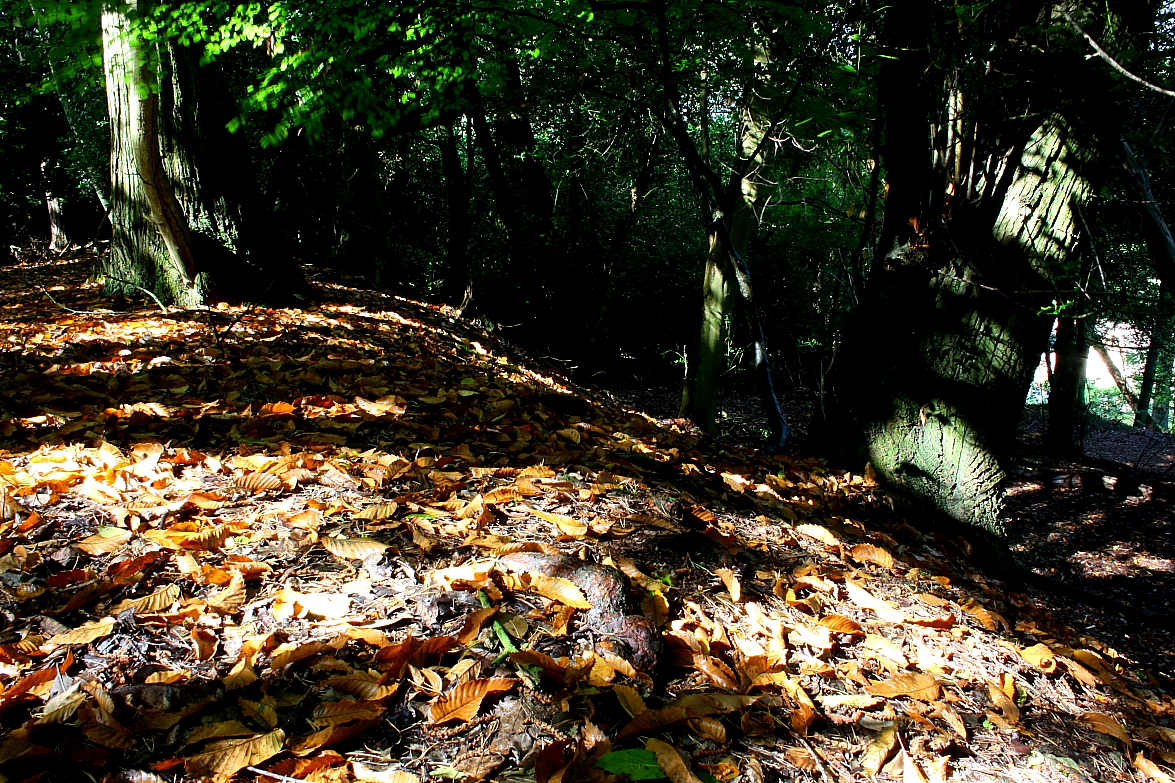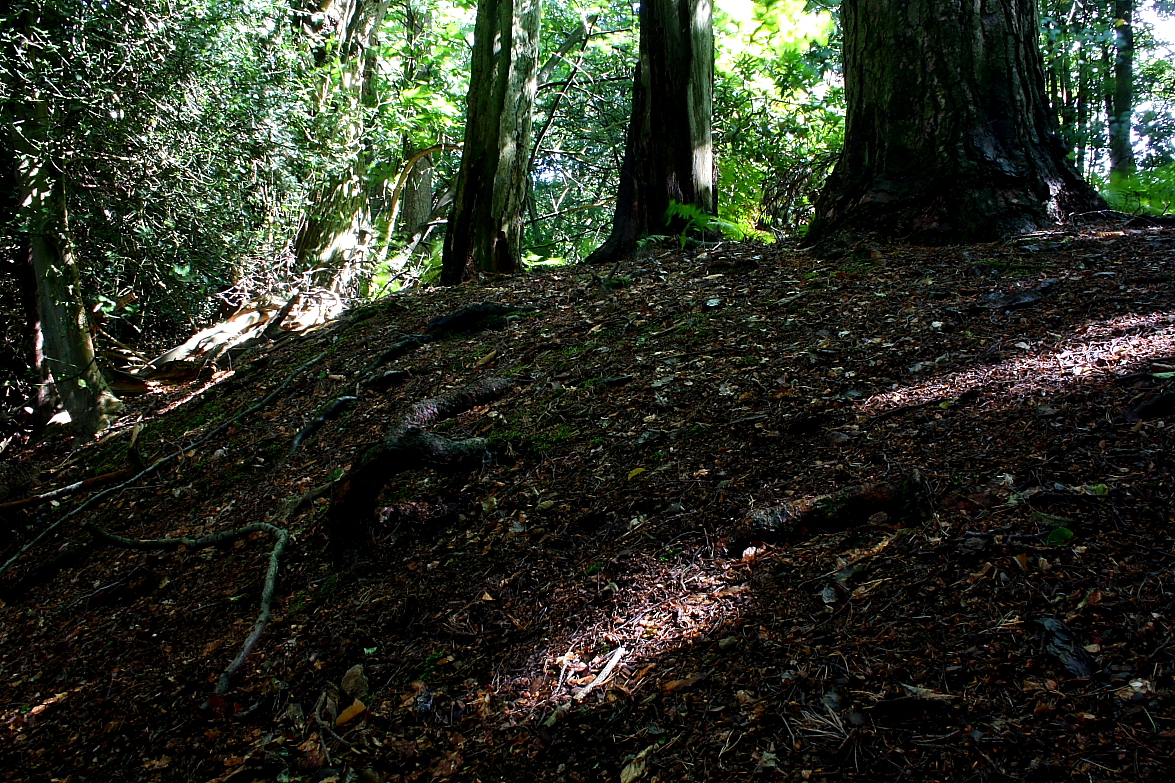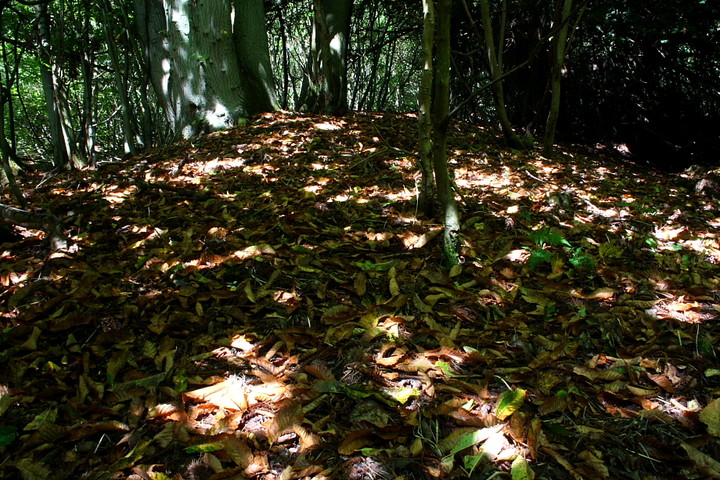




Inner rampart, to west. An other substantial rampart can be seen bottom left.

Anstiebury is significantly overgrown in places.... a slumbering behemoth.


This is a vibey enclosure when sunlight streams through the foliage.

To north-east.... mesmeric.


Eastern flank.... oh, and a toadstool.


Natural defences are all that is really needed to the south, the hillside being really, really steep out of shot bottom right.

The most accessible section of ramparts to the west.... Gladman to emphasise scale of these impressive defences.

Towards the middle rampart, northern arc.

Inner rampart to west.

Inner rampart, north-west (ish)

The powerful inner rampart to the north of the enclosure.
Like its companion Iron Age enclosure at Holmbury, some three miles to the approx west, Anstiebury is a promontory fort, the landscape falling sharply away to the south rendering additional artifical defences all but superfluous at that point. That, however, may well be the sole similarity..... Anstiebury is thickly cloaked with woodland to the point of ‘Howard Hughes’ style reclusiveness, just the occasional local to be seen exercising his/her dog within its environs, whilst Holmbury is the focus of a multitude of weekend walkers and so-called ‘mountain-bikers’ racing along tracks between its ramparts. Poor Holmbury. In fact there is no public access to Anstiebury, as implied in jimit’s post [by the way, thanks to jimit for the prompt to visit this wonderful site]. However I am emboldened (amongst other things... ahem) by a beautiful smile from a rather attractive local emerging – with pooch – from what Dyer suggests is the enclosure’s original entrance to the approx north-east... that is on to Anstie Lane. Another encounter – with a very polite and friendly youth, restraining a not so friendly, not to mention barking (ha!) Alsatian – would suggest unofficial visits by courteous TMA-ers (is there any other kind?) are tolerated? But don’t hold me to that since, hey, it could have just been the devastating Gladman charm. C’mon, give me a break. It is at least possible. Isn’t it?
Heading anti-clockwise it is immediately apparent that the ‘Howard Hughes’ analogy is perhaps not that far off the mark; the ancient fortress, although severely overgrown, remains substantial and sophisticated within its woodland hideout .... tri-vallate except, as previously noted, to the south, where only the fore-runners of Hardrada’s beserkers would’ve attempted an assault. Yeah, I (foolishly) tested the slope myself... you would have to be a nut. The most pronounced section of the defences is currently at the approx north-west, where the banks are more or less shorn of vegetation, if not tree cover. This happy state of affairs allows the intermittent sunlight to stream through the canopy directly onto the leaf strewn ramparts. The variation of colour upon this ‘canvas’ envokes thoughts/feelings I only wish I was capable of relating with words. I therefore switch to film... sorry, digital image. Perhaps these suggest something, perhaps a hint of some repressed folk memory of life in the ancient, virgin forest which apparently once covered this planet? Legends of Herne, The Green Man and the like. Jeez, I can see where they came from, and that’s a fact.
Dyer reckons that excavation suggests Anstiebury may have been assaulted and destroyed before it was even completed, judging by the discovery of much slingshot and a destroyed inner rampart face. If this is true, the contrast between the catastrophic violence and hatred of that day and today’s peaceful, ethereal vibe is total.
Making enquiries at the nearby pub (as you do) the Plough Inn at Coldharbour, it was pointed out that it is on private land and the owner doesn’t like people “Wandering over his land with Geiger Counters”, the mind boggles! Might try to get his address and request a visit.
A legend survives in connection with the storming of Entons Castle [at Capel], which relates that the Danes, having captured the stronghold, carried away the castle gates and bell to Anstiebury Camp, whither they also took the female captives accumulated in the course of their victorious progress through the Hundred of Wotton.
The women one night contrived to admit a number of Saxon warriors, who overcame the garrison and afterwards hung the recovered castle-bell in Capel church steeple.
Walter Moore in the Dorking and Leatherhead Advertiser, 24th June 1905.
” 1 mile NE of Leith Hill. An Iron Age fort, Oval in plan, enclosing 11 1/2 acres. To the NE and NW the defences are triple banks with double ditches and there are signs of a third ditch to the NE. An entrance at the NNE is probably original. A date of construction between C2 and the C1 Bc may be guessed- the site awaits proper excavation. Holmbury Camp is near by.....”
From “The Buildings of England” Surrey. Nairn Pevsner Cherry ISBN 140710213
‘Devoted Churchman Donald Maxwell RA’ was converted to Alfred Watkins’ ley theories. He wrote ‘topographical detective tales’ in the 1930s, and this article by Stephen Daniels includes one of his prints to illustrate one of the novels.
Here’s a direct link to the picture:
tate.org.uk/research/tateresearch/tatepapers/06autumn/images/daniels_fig9large.jpg
“From the wooded heights of Anstiebury Camp there ran invisible lines over hill and dale.”









